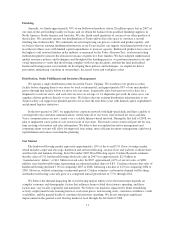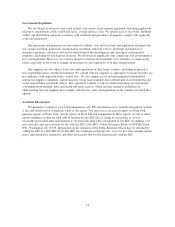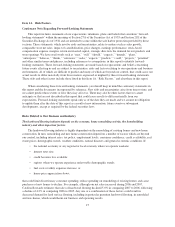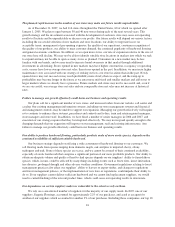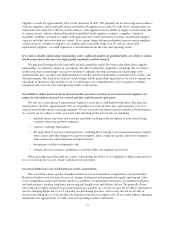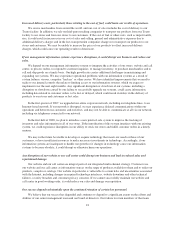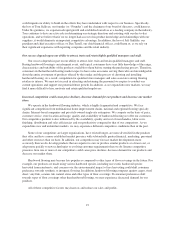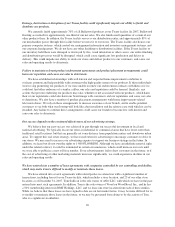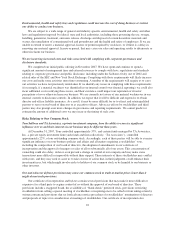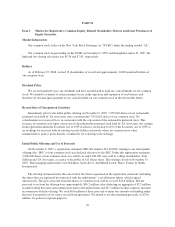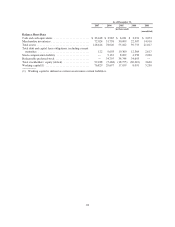Lumber Liquidators 2007 Annual Report Download - page 27
Download and view the complete annual report
Please find page 27 of the 2007 Lumber Liquidators annual report below. You can navigate through the pages in the report by either clicking on the pages listed below, or by using the keyword search tool below to find specific information within the annual report.We may incur non-cash compensation expenses in connection with an existing stock-based compensation
agreement.
We are party to a stock-based agreement between Tom and his brother, Kevin Sullivan, a regional manager,
accounted for as a variable performance plan (the “Variable Plan”). The Variable Plan was established in 1998
and modified in August 2005. The Variable Plan awarded Kevin the right (the “Variable Right”) to an ownership
percentage of our common stock. The percentage was defined as a fixed percentage of 2.5% of our common
stock on a fully diluted basis, as defined in the agreement, plus an additional percentage based on certain
performance criteria, primarily a comparison of the net income of the region under Kevin’s management to our
total net income on a trailing twelve-month basis. Under the Variable Plan agreement, we were required to
determine the number of shares of common stock exercisable under the Variable Right at vesting. The common
stock earned under the Variable Right would be contributed by Tom, and 1.5 million shares of our common stock
were placed in escrow by Tom, representing the maximum amount of shares Tom and Kevin believed would be
earned under the Variable Right.
The Variable Right fully vested and became exercisable in connection with the initial public offering (or
“IPO”), and all cash settlement provisions via put-call rights terminated. In accordance with the terms of the
Variable Plan, we calculated that 853,853 shares of our common stock had vested and were exercisable under the
Variable Right (the “Vested Shares”). Cumulative stock-based compensation expense related to the Variable Plan
was calculated utilizing that share count and the $11 per share IPO price to adjust the liability on our balance
sheet under the line item “Stock Compensation Liability” to $9.4 million representing $0.3 million of 2007 stock-
based compensation expense. The Stock Compensation Liability was reclassified to the line item “Additional
Capital” on our balance sheet in accordance with the provisions of Statement of Financial Accounting Standards
(“SFAS”) No. 123(R), Share-Based Payment (“SFAS 123(R)”).
Kevin filed for arbitration on December 7, 2007 disputing our share count calculation. Total stock-based
compensation expense related to the Variable Plan was $3.2 million for the year ended December 31, 2007,
which included our best estimate of the ultimate value of incremental shares (above the Vested Shares) that may
be delivered to Kevin via settlement or arbitration. As the ultimate value that may be delivered to Kevin is not
certain, we may be required to adjust stock-based compensation expense in 2008.
In addition, on March 11, 2008, we received a copy of a complaint that Kevin purportedly sent to the Fair
Labor Division of the Office of the Attorney General of Massachusetts, which alleges that the Founder and we
have unlawfully withheld wages from Kevin by not releasing to him a specified portion of the escrowed shares of
common stock. We are not a party to the escrow arrangement between the Founder and Kevin. Kevin is seeking a
prompt release of those shares, together with certain additional damages that could potentially be subject to
trebling under relevant law. At this time, it is not possible for us to determine the ultimate resolution of, or
reasonably estimate any potential liability from, this matter, and no provision for losses has been provided in
connection with this complaint. We intend to defend this matter vigorously.
We may not be able to adequately protect our intellectual property, which could harm the value of our brands
and harm our business.
Our intellectual property is material to the conduct of our business. Our ability to implement our business plan
successfully depends in part on our ability to further build brand recognition using our trademarks, service marks and
other proprietary intellectual property, including our name and logo and the names of our brands. If our efforts to
protect our intellectual property are inadequate, or if any third party infringes on or misappropriates our intellectual
property, either in print or on the Internet, the value of our brands may be harmed, which could adversely affect our
business and might prevent our brands from achieving or maintaining market acceptance. We may also encounter
claims from prior users of similar intellectual property in locales where we operate or intend to operate. This could
harm our image, brand or competitive position and cause us to incur significant penalties and costs.
21


